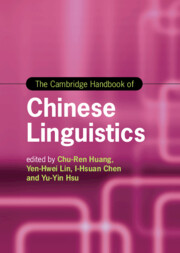Book contents
- The Cambridge Handbook of Chinese Linguistics
- Cambridge Handbooks In Language and Linguistics
- The Cambridge Handbook of Chinese Linguistics
- Copyright page
- Contents
- Figures
- Tables
- Contributors
- Acknowledgments
- Part One Writing System/Neuro-cognitive Processing of Chinese
- Part Two Morpho-lexical Issues in Chinese
- Part Three Phonetic-phonological Issues in Chinese
- 11 The Morphophonology of Chinese Affixation
- 12 Mandarin Chinese Syllable Structure and Phonological Similarity
- 13 Tonal Processes Defined as Articulatory-based Contextual Tonal Variation
- 14 Tonal Processes Defined as Tone Sandhi
- 15 Tonal Processes Conditioned by Morphosyntax
- 16 Tone and Intonation
- 17 Evidence for Stress and Metrical Structure in Chinese
- 18 Perceptual Normalization of Lexical Tones
- Part Four Syntax-semantics, Pragmatics, and Discourse Issues
- Index
- References
17 - Evidence for Stress and Metrical Structure in Chinese
from Part Three - Phonetic-phonological Issues in Chinese
Published online by Cambridge University Press: 04 August 2022
- The Cambridge Handbook of Chinese Linguistics
- Cambridge Handbooks In Language and Linguistics
- The Cambridge Handbook of Chinese Linguistics
- Copyright page
- Contents
- Figures
- Tables
- Contributors
- Acknowledgments
- Part One Writing System/Neuro-cognitive Processing of Chinese
- Part Two Morpho-lexical Issues in Chinese
- Part Three Phonetic-phonological Issues in Chinese
- 11 The Morphophonology of Chinese Affixation
- 12 Mandarin Chinese Syllable Structure and Phonological Similarity
- 13 Tonal Processes Defined as Articulatory-based Contextual Tonal Variation
- 14 Tonal Processes Defined as Tone Sandhi
- 15 Tonal Processes Conditioned by Morphosyntax
- 16 Tone and Intonation
- 17 Evidence for Stress and Metrical Structure in Chinese
- 18 Perceptual Normalization of Lexical Tones
- Part Four Syntax-semantics, Pragmatics, and Discourse Issues
- Index
- References
Summary
There is a common view that English has word stress but Chinese does not. I examine perceived stress in disyllabic lexical entries and show two similarities between the languages: (i) when both syllables carry a designated tone, such as such as bamboo or Red Cross in English, or 北京 Beijing ‘Beijing’ in Chinese, main stress is unclear to native speakers; and (ii) when just one syllable has a designated tone, such as yoga, magpie, or about in English, or 爸_爸 ba_ba [paː][pə] ‘pa_pa (papa)’ in Chinese, it is clearly perceived to carry main stress. However, case (ii) covers 86% of disyllabic entries in English but just 5% in Chinese. The difference is attributable to the independent fact that Chinese is a tone language, in which syllables with secondary stress also carry a designated tone, whereas in English they usually do not. I also show that English and Chinese share two further similarities: First, stressed and unstressed syllables are acoustically different, and second, stress plays other phonological roles, such as phrasal stress, contrastive stress, and meter in poetry.
- Type
- Chapter
- Information
- The Cambridge Handbook of Chinese Linguistics , pp. 361 - 382Publisher: Cambridge University PressPrint publication year: 2022



